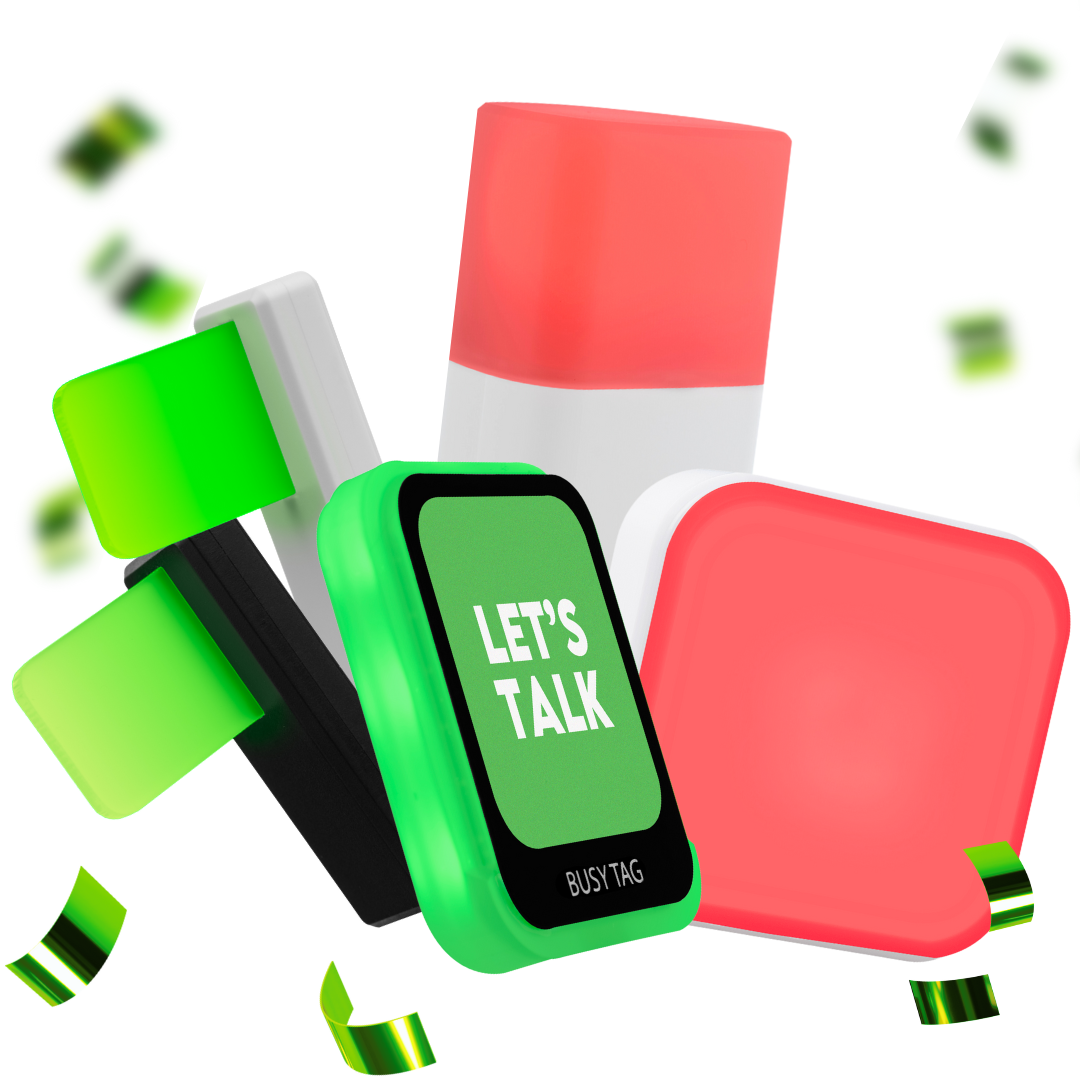Complete Guide to Office Communication Signals with Luxafor

The modern workplace is evolving. So are its norms and procedures for office communication. We may have to bid adieu to the traditional 9–5 schedule, full-time employment, and actual offices in a few years. Instead, a workplace could turn into a collection of independent contractors who are engaged on a need-basis for projects with set durations, free to go on to the next project after their work is over. The only thing left to do is adjust to the shift.
One thing is certain, though, regardless of the shape that the workplaces of the future take. They will still need to communicate in order to complete the task. In this article, we examine the most prevalent workplace communication issues that exist across all industries and the consequences they have for an organization's overall performance. Finally, how to get past them.
Common Challenges in Office Communication
Office communication will inevitably evolve as offices grow more dispersed and completely remote. This transition from in-person meeting spaces to asynchronous contact through email and instant messaging can be difficult.
It is clear that effective workplace communication will become crucial to businesses' decision-making and daily operations when you consider the growing diversity of the workforce and its different needs.
Problem 1: Insufficient communication plan
The already difficult corporate communication procedures have been made worse by the ongoing pandemic. With little to no sharing between teams, each team frequently discusses and works on assignments using its own set of communication tools. These routes of communication are becoming more and more numerous. Additionally, businesses frequently lack a formal information governance plan to control this information flow.
Businesses had to quickly adjust as the epidemic struck, frequently going entirely online. As a result, the majority of previously in-person interactions has to shift to the internet. And because it placed a strong emphasis on recording everything that happened, this was a huge issue.
Problem 2: Diverse means of communication
Since every communication channel must be maintained and groomed, this just increases workload and impairs effectiveness and focus. It can be annoying and challenging to make sure that everyone in charge is informed when staff members must communicate information through multiple channels.
Being creative and finding new channels and tools is perfectly acceptable, but it's crucial to do it at a time and pace that other team members can keep up with.
Once more, this problem stems from a lack of a communication plan. There will probably be less noise from new channels of communication if staff members feel that their opinions were heard when developing the plan.
How to Read Office Communication Signals
Trying to define "efficient" office communication at work is an unappreciative effort. Every business is a different system with its own set of dynamics and regulations that must be considered. Our approach to making it happen is as follows:
Roles and obligations that are clear
Absolutely necessary. No matter how complicated the system you're working in is, communication will inevitably result in noise and few business-oriented, useful signals if roles aren't clearly defined.
Lack of boundaries causes roles to become hazy, which in turn causes incessant communications, team meetings, and back and forth. Welcome to increased turnover, disgruntled employees, and workplace exhaustion.
Sharing and saving knowledge
Persistent corporate records and knowledge transfer are very important to us as an archiving organization. Therefore, it should be no surprise that our approach to effective business communication calls for regular knowledge management and storage. And it really does pay off, in our experience.
Maintaining the lessons learnt along the process is essential if the team is to truly get to the point where communication is effective. This entails maintaining a specific directory where team members may learn about the work being done by other business divisions, the most recent trends, possible process hitches, and other topics.
What is Luxafor Signals and How to Use Them
A line of smart lighting products called Luxafor Signals is intended to facilitate and improve workplace communication. Desk-mounted Luxafor Flags, freestanding Busy Light, and Bluetooth-enabled wireless solutions are all part of the collection. Colleagues can quickly determine if you're free, occupied, or in a meeting with the help of these lights, which employ programmable LED colors to signal your availability without interrupting you.
Setting Up Luxafor Signals for Your Team
Luxafor makes it easy to get started. The application easily integrates with your calendar other teamwork applications, and devices can be connected via USB or wireless. To ensure that everyone is utilizing the same visual language, you can change the light colors and patterns after installation to suit your team's communication preferences.
Encourage team members to use it consistently for the best outcomes. To ensure that everyone remembers it, establish basic etiquette guidelines and stick to a modest, limited color scheme. These routines eventually make Luxafor a seamless component of everyday tasks, keeping your staff connected, engaged, and more efficient.
Best Practices in Office Communication Using Visual Signals and Etiquette
Organizations must consider the ethical necessity of open and honest communication to be one of their basic principles. All levels of an organization should have thorough rules and methods for workplace communication.
- Assess Your Needs: Consider the unique requirements of your office before using new visual communication technologies. Consider the size of the team, the workplace layout, and any communication issues that may be present. This will assist you in selecting the visual signals that work best for your particular circumstance.
- Assist and Train: Ensure that everyone understands the purpose and application of the new visual communication tools. To make the most of these systems, provide training sessions and establish explicit instructions. Keep in mind that everyone must use visual cues correctly and consistently for them to be effective.
Like any office communication strategy, it's critical to routinely assess the effectiveness of your visual cues. Get employee input and be prepared to make adjustments if necessary. Keep your options open because the aim is to develop a system that enhances communication.
Real-Life Examples of Luxafor Signals in Action
The best application of Luxafor signals is as a communication tool that substitutes clarity for guesswork. A red light during a conference, for instance, instantly conveys "do not disturb," whereas a green light indicates "available for a quick chat" in a bustling office. A yellow or blinking indicator informs teammates that you have taken a brief break but will return shortly, making even brief pauses more understandable.
Luxafor improves cross-location communication in hybrid teams. When a remote worker's light is synced with Zoom or Microsoft Teams, it signals their availability to coworkers in the office just as clearly, minimizing missed connections and misplaced expectations.
Conclusion: Streamlining Team Communication and Productivity
A straightforward yet effective method for reducing disruptions, indicating availability, and improving workflow for both people and groups is to use Luxafor signals. Focus lights and customized status indicators allow staff to concentrate when needed, work together more efficiently, and foster a respectful office communication culture.
FAQ
What are office communication signals?
Visual clues that indicate a person's availability or status at work are known as office communication signals. Without disturbing others, they let coworkers know when someone is available, occupied, or in a meeting. Lights, flags, and other signs that are used uniformly by the team can all be considered signals.
How to use Luxafor Busy Lights?
Install the included software after plugging your Luxafor Busy Light into your computer or Bluetooth device. Assign patterns or colors to denote various states; for example, green indicates "available" and red indicates "do not disturb." Additionally, it may be integrated with communication tools and calendar apps to automate adjustments during concentrate time or meetings.
How do Luxafor signals improve team collaboration?
Without interfering with in-depth work, Luxafor signals make it simple to determine who is accessible for brief team collaboration. They enable everyone to concentrate on their work by minimizing misunderstandings and averting needless interruptions. Visual cues give everyone's status instantaneous, unambiguous context, which helps teams stay in sync.
What are the best practices for office etiquette with busy lights?
Recognize the significance of each light hue and pattern, particularly red during meetings or focus periods. Prior to interrupting a colleague, find out how they are doing. Encourage the team to use the same color codes consistently. To preserve clarity and respect, combine signals with office etiquette practices, such as follow-up texts or planned check-ins.














